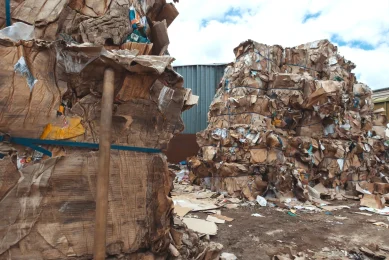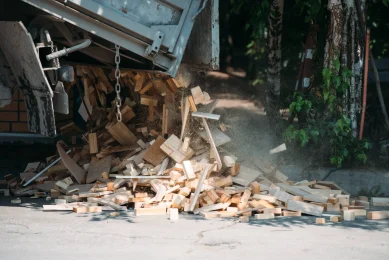Construction and demolition waste - definition
Construction and demolition waste is the total of waste generated during construction work: construction, reconstruction, renovation, demolition or assembly. Among them, 2 main categories can be distinguished: post-construction waste generated by households and post-renovation waste generated during construction work carried out by economic operators.
According to the provisions of the Waste Act of 14 December 2012, construction and demolition waste is not included in the group of municipal waste. Consequently, this type of waste requires special management, e.g. by companies involved in ecology, disposal and recovery of raw materials and materials. The services of such companies are used by both individuals and businesses, ordering the collection and removal of construction waste in rubble containers or big bags.
Types and codes of construction and renovation waste
Construction and renovation waste can be classified according to, among other things, its origin, the degree of purity or mixing of different materials and the type of entity generating it (individuals or companies).
From the point of view of entrepreneurs generating construction and renovation waste, the classification introduced in the waste catalogue is important. Construction and demolition waste is classified in group 17 and numerous sub-groups as:
- waste construction materials and components (e.g. concrete, bricks, tiles, ceramics) - waste codes starting with 17 01,
- waste wood, glass and plastics - waste codes starting with 17 02,
- bituminous mixtures, tar and tar products - waste codes beginning with 17 03,
- Metallic and metal alloy wastes and scrap - waste codes beginning with 17 04,
- soil and earth (e.g. from excavations) - waste codes starting with 17 05,
- insulation materials and construction materials containing asbestos - waste codes beginning with 17 06,
- construction materials containing gypsum - waste codes starting with 17 08,
- other construction, renovation and dismantling waste (e.g. containing hazardous substances) - waste codes starting with 17 09.
We can also divide construction and renovation waste into clean rubble, mixed rubble and contaminated rubble.
The following are classified as clean rubble:
- concrete waste and concrete rubble from demolition and renovation - waste code 17 01 01,
- brick rubble - waste code 17 01 02,
- soil, earth, including stones - waste code 17 05 04.
Mixed rubble can be classified under 2 waste codes:
- 17 01 07 for mixed waste from concrete, brick rubble, waste ceramic materials and fittings,
- 17 09 04 for mixed construction, renovation and dismantling waste.
Contaminated rubble should only be classified under 1 waste code - 17 09 04, i.e. mixed construction, renovation and dismantling waste other than those mentioned in 17 09 01, 17 09 02 and 17 09 03. Interestingly, many contractors abandon the meticulous sorting of construction waste and classify most of it precisely as mixed construction waste.
Construction and renovation waste - new obligations for construction companies
Previous regulations did not impose an obligation on entrepreneurs generating construction and demolition waste to collect it separately. However, such an obligation is introduced by the Amendment to the Waste Act of 11 August 2021, which will enter into force in 2025. Pursuant to the new regulations, each entrepreneur generating construction waste will be obliged to sort it into 6 fractions:
- mineral waste (including concrete, bricks, tiles and ceramic materials and stones),
- gypsum,
- plastics,
- wood,
- Glass,
- metals.
This means that, as of 1 January 2025, renovation and construction companies will be forced to order up to 6 different rubble containers instead of 1 container for mixed construction waste, as is currently the case. However, these regulations will not apply to categories of construction and demolition waste for which there is no obligation to keep waste records.
Storage and collection of construction and renovation waste
The storage of construction and demolition waste may only be carried out by entities with a special permit and only for the purpose of storing it for organisational or technological processes. Furthermore, it is prohibited to store construction waste in the same container as municipal waste. It is also not permitted to mix post-construction waste with other waste fractions. For this reason, entrepreneurs generating different types of waste, including construction and demolition waste, usually use a separate container for debris or (in the case of smaller quantities of waste) debris bags, so-called big bags.
Learn about the types, dimensions and capacities of the most popular waste containers.
The entrepreneur who is the generator of construction and demolition waste is obliged to manage it. Most often, this consists of ordering a collection, removal and disposal service from a professional environmentalist company. In this way, it is possible to separate the different fractions of construction waste, recover them and reuse them.
In parallel with the procurement of a collection and disposal service for construction waste, the company is obliged to issue a Waste Transfer Note in the BDO system. It shall contain the data of the waste transmitter, transporter and receiver, the identity of the means of transport (e.g. registration number of the vehicle), the type and code of the waste and the weight of the waste transferred.
Construction waste vs BDO - when is a construction company required to register with the system?
In principle, Any contractor generating construction and demolition waste is obliged to register with BDO. However, there are some exemptions, which exempt entrepreneurs generating small amounts of construction waste from the obligation to register with BDO and maintain KEO. The codes for these wastes and their weights are set out in the Decree of the Minister of Climate of 23 December 2019 on the types of waste and quantities of waste for which no waste records are required as of 30 December 2019.
The weight limits for each waste code exempting registration with BDO and record-keeping are shown below:
- concrete waste and concrete rubble from demolition and renovation with waste code 17 01 01 - up to 10 tonnes,
- brick rubble with waste code 17 01 02 - up to 10 tonnes,
- up to 10 tonnes of waste other ceramic materials and equipment, code 17 01 03,
- mixed concrete waste, brick rubble, waste ceramic materials
and equipment code 17 01 07 - up to 10 tonnes,
- removed plaster, wallpaper, veneer, etc. with code 17 01 80 - up to 5 tonnes,
- wood with code 17 02 01 - up to 10 tonnes,
- glass with code 17 02 02 - up to 5 tonnes,
plastics with code 17 02 03 - up to 5 tonnes, - copper, bronze, brass with code 17 04 01 - up to 5 tonnes,
- lead with code 17 04 03 - up to 5 tonnes,
- zinc with code 17 04 04 - up to 5 tonnes,
iron and steel with code 17 04 05 - up to 5 tonnes, - tin with code 17 04 06 - up to 5 tonnes,
metal mixtures with code 17 04 07 - up to 5 tonnes, - soil and earth, including stones, other than those mentioned in 17 05 03 17 05 04 - up to 20 tonnes,
- construction materials containing gypsum other than those listed in 17 08 01 - up to 10 tonnes.
Exceeding the designated limits for a given waste code obliges the entrepreneur to register with BDO and to keep waste records. Your company generates higher volumes of construction waste but is not yet on the BDO register? Use our step-by-step instructions for registering with BDO
NOTE: the said Obligation to register with the BDO, to issue Waste Transfer Notes (WTP) and to keep Waste Inventory Cards (WERC) only applies to entrepreneurs. Individuals who generate construction waste (e.g. in the course of renovating their own house or flat) are not obliged to keep records of construction and renovation waste or to issue waste transfer notes.
Simplified construction waste management with the Interzero Waste Platform
The management of construction and demolition waste in BDO-registered companies involves the need to coordinate waste collections and removals, as well as keeping records and issuing KPOs at the same time. The scale of these obligations increases with the size of the company, the number of its branches and the dispersion of the construction projects handled by the entrepreneur in question.
The optimum solution for entrepreneurs generating large amounts of construction and demolition waste is to use an online system for the company's comprehensive waste management. The Interzero Waste Platform is a digital tool that allows waste collections to be ordered remotely and collection schedules to be created, as well as Waste Transfer Cards to be automatically issued, approved and corrected with 1 click.
The platform is integrated with the BDO system, eliminating the need to log into the government system. Its functionalities are further enhanced by:
- the possibility of storing environmental documentation in a digital repository,
- automatic maintenance of waste records in the form of KEOs,
- the ability to monitor the flow of waste streams and manage all waste management costs.
A comprehensive tool such as the Interzero Waste Platform relieves entrepreneurs of their duties in managing construction waste and other waste fractions and minimises the risk of errors when entering data into BDO. It also reduces waste management costs while increasing profits from raw material sales. All or selected functionalities of the Platform are covered by a free trial period of up to three months



